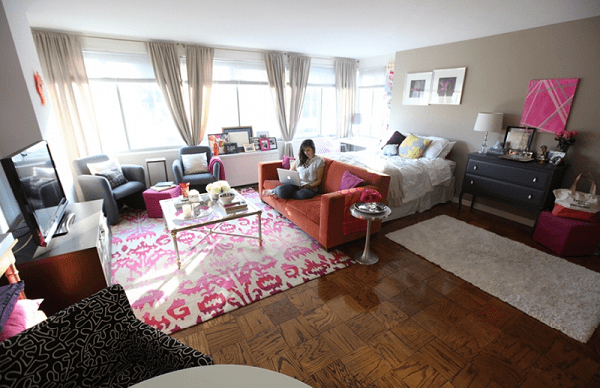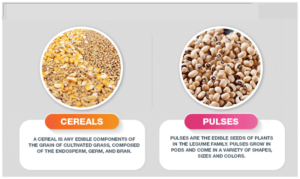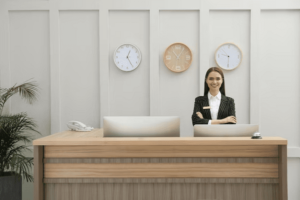Types of room efficiency- Room efficiency can refer to different aspects depending on the context, such as energy efficiency, space utilization, or workflow efficiency. Here are several types of room efficiency:
- Energy Efficiency: This focuses on optimizing the energy consumption of a room, such as through the use of energy-efficient appliances, lighting, and HVAC systems. Well-insulated windows and walls also contribute to energy efficiency.
- Space Efficiency: Space efficiency is about maximizing the utility of a room while minimizing wasted space. This can involve clever storage solutions, modular furniture, and efficient layout design to make the most of the available space.
- Workflow Efficiency: In commercial or industrial settings, workflow efficiency aims to create a room layout that promotes efficient work processes. This might involve organizing equipment, workstations, and pathways to reduce unnecessary movement and streamline operations.
- Material Efficiency: Material efficiency relates to using resources effectively and minimizing waste during construction or renovation. Using sustainable materials and practices can contribute to material efficiency.
- Time Efficiency: In a room used for work or production, time efficiency focuses on minimizing delays and optimizing productivity. It can involve process optimization, automation, and the elimination of bottlenecks.
- Cost Efficiency: Cost efficiency is about reducing the overall costs of operating and maintaining a room. This could involve measures like using cost-effective materials, energy-saving technologies, and efficient maintenance practices.
- Maintenance Efficiency: This aspect involves designing a room in a way that makes maintenance tasks easier and less time-consuming. For example, using easily accessible fixtures and equipment, as well as materials that are low-maintenance.
- Safety Efficiency: Ensuring that a room is safe and secure can be viewed as safety efficiency. This includes measures like installing fire safety equipment, proper lighting, and security systems.
- Comfort Efficiency: In living spaces, comfort efficiency is about creating a comfortable environment. This may involve climate control, soundproofing, and the choice of furniture and decor to enhance well-being.
- Environmental Efficiency: Focusing on the environmental impact of a room’s design and operation. This includes incorporating eco-friendly materials, reducing waste, and minimizing the carbon footprint of a room.
- Health and Wellness Efficiency: Designing rooms to promote physical and mental well-being. This may involve natural lighting, air quality, and the use of biophilic design elements.
- Aesthetic Efficiency: Aesthetic efficiency is about creating a visually pleasing room that aligns with the intended purpose and appeals to the occupants. This involves thoughtful design choices and decor selection.
Each of these types of room efficiency can be important in different contexts and for various purposes. The specific focus on one or more types of efficiency will depend on the goals and priorities of the room’s design and use.
What is Required Types of room efficiency
“Required types of room efficiency” typically depend on the specific purpose and needs of the room. Different rooms serve different functions, so the required types of efficiency will vary accordingly. Here are some examples of required types of room efficiency for various purposes:
- Residential Room Efficiency:
- Space Efficiency: Maximizing living space in bedrooms, living rooms, and kitchens.
- Energy Efficiency: Reducing energy consumption through insulation, energy-efficient appliances, and lighting.
- Comfort Efficiency: Ensuring comfort through heating, cooling, and soundproofing.
- Aesthetic Efficiency: Creating pleasing aesthetics in bedrooms, living rooms, and bathrooms.
- Office Room Efficiency:
- Workflow Efficiency: Optimizing layouts to enhance productivity.
- Technology Efficiency: Integrating technology for seamless operations.
- Space Efficiency: Efficient use of workspace to accommodate employees.
- Cost Efficiency: Minimizing operating costs through energy-efficient systems.
- Industrial Room Efficiency:
- Workflow Efficiency: Streamlining manufacturing processes.
- Safety Efficiency: Ensuring a safe work environment with proper equipment and protocols.
- Maintenance Efficiency: Designing for easy equipment maintenance and repairs.
- Energy Efficiency: Reducing energy consumption in industrial facilities.
- Hospital Room Efficiency:
- Workflow Efficiency: Arranging equipment and workspaces for efficient patient care.
- Health Efficiency: Maintaining a hygienic and sanitary environment.
- Safety Efficiency: Ensuring patient and staff safety with the right facilities.
- Comfort Efficiency: Enhancing the patient’s experience.
- Classroom Efficiency:
- Teaching Efficiency: Creating layouts that support effective teaching and learning.
- Space Efficiency: Arranging desks and equipment for optimal use of space.
- Technology Efficiency: Integrating technology for educational purposes.
- Data Center Efficiency:
- Energy Efficiency: Reducing power consumption and heat generation.
- Cooling Efficiency: Effective cooling systems to maintain optimal temperatures.
- Space Efficiency: Maximizing server and equipment placement within the room.
- Restaurant Efficiency:
- Workflow Efficiency: Streamlining kitchen and service operations.
- Customer Experience Efficiency: Creating a comfortable and welcoming dining environment.
- Cost Efficiency: Minimizing food and labor costs.
- Retail Store Efficiency:
- Space Efficiency: Maximizing the use of space for product display.
- Aesthetic Efficiency: Creating an attractive shopping environment.
- Inventory Efficiency: Managing inventory effectively to meet demand.
The specific types of room efficiency required will depend on the goals and functions of the room. It’s important to identify the priorities for efficiency in a given context and design the room accordingly.
When is Required Types of room efficiency
“Required types of room efficiency” doesn’t refer to a specific date or time. It’s not a point in time; it’s a concept that pertains to the various aspects of efficiency that should be considered when designing or evaluating a room for a specific purpose.
The required types of room efficiency depend on the specific needs and functions of the room. These types of efficiency are relevant during the planning, design, construction, and operation phases of a room or building. They are considered throughout the entire lifespan of the space to ensure it serves its intended purpose efficiently.
Where is Required Types of room efficiency

“Required types of room efficiency” are not a physical location or a specific place. This phrase refers to the various aspects and considerations related to efficiency that are necessary or required in the design, construction, and operation of different types of rooms. The specific types of room efficiency that are required will depend on the purpose and function of the room in question.
These considerations can be applied to various locations where rooms are designed and used, including residential buildings, commercial spaces, industrial facilities, healthcare institutions, educational settings, and more. They are not tied to a single physical location but are relevant in a wide range of settings where efficient use of space and resources is important.
How is Required Types of room efficiency
The efficiency of a room, or the “required types of room efficiency,” depends on various factors and considerations. Here’s how it can be evaluated and achieved:
- Define the Purpose: To determine the required types of room efficiency, you must first define the purpose of the room. Is it a bedroom, office, kitchen, or some other type of space? The function of the room will dictate the specific types of efficiency required.
- Identify Key Efficiency Metrics: Once the purpose is defined, identify the key efficiency metrics relevant to that room. For example:
- Energy Efficiency: Focus on reducing energy consumption through energy-efficient appliances and lighting.
- Space Efficiency: Maximize space utilization for storage or activities.
- Workflow Efficiency: Optimize the room layout for efficient work processes.
- Comfort Efficiency: Ensure a comfortable environment through climate control and design.
- Safety Efficiency: Implement safety features and practices appropriate for the room.
- Design and Layout: Design the room’s layout, taking into account the metrics you’ve identified. Use space efficiently, arrange furniture or equipment thoughtfully, and consider factors like lighting, insulation, and ventilation.
- Select Appropriate Materials: Choose materials and fixtures that align with your efficiency goals. This might include energy-efficient windows, low-maintenance materials, or safety features.
- Technology and Automation: Integrate technology and automation where applicable to enhance efficiency. For example, using a smart thermostat for energy efficiency or automated workflows for workflow efficiency.
- Regular Maintenance: Ensure that the room is maintained properly to retain its efficiency over time. This includes addressing wear and tear, replacing or upgrading equipment as needed, and conducting regular inspections.
- Evaluate and Adjust: Periodically assess the room’s efficiency. If you’re not meeting your efficiency goals, make adjustments as necessary. This could involve upgrades, renovations, or process changes.
- Compliance and Standards: Be aware of any industry or local standards related to efficiency in certain types of rooms. Compliance with these standards may be required or advisable.
- Sustainability: Consider sustainability and environmental factors in your efficiency efforts. Using eco-friendly materials, reducing waste, and minimizing energy consumption can contribute to overall efficiency.
- User Feedback: If the room is used by people, gather feedback from the occupants. Their input can be valuable in identifying areas for improvement.
Efficiency is a dynamic concept that can evolve over time. The required types of room efficiency are specific to the room’s function and the goals you aim to achieve. Regular evaluation and adjustments are essential to maintain and improve efficiency in any room.
Case Study on Types of room efficiency
Title: Renovation of a Residential Living Room for Efficiency
Background: A family of four in a suburban home decided to renovate their living room to make it more efficient and comfortable. The existing living room was outdated, poorly insulated, and had a less-than-optimal layout.
Types of Room Efficiency Considered:
- Space Efficiency:
- The family wanted to maximize the use of space for both family time and entertaining guests.
- A custom-built wall unit with integrated storage solutions was designed to house the TV, books, and decor, reducing clutter and making the room feel more spacious.
- Furniture was selected with space-saving features, such as a fold-out sofa bed for occasional guests.
- Energy Efficiency:
- The room was not well insulated, leading to temperature fluctuations and high heating/cooling costs.
- The renovation included upgrading insulation in walls and the ceiling.
- Energy-efficient windows and LED lighting were installed to reduce energy consumption.
- Aesthetic Efficiency:
- The family aimed for an aesthetically pleasing living room.
- A neutral color scheme with pops of color was chosen to create a harmonious and inviting atmosphere.
- Thoughtful decor and artwork were selected to enhance the room’s visual appeal.
- Comfort Efficiency:
- Maintaining comfort throughout the year was a priority.
- A programmable thermostat was installed to regulate temperature efficiently.
- Proper placement of comfortable seating and the addition of cozy textiles like throw blankets and cushions contributed to a comfortable atmosphere.
Implementation:
- The renovation began with insulation and structural improvements to enhance energy efficiency.
- The room layout was reconfigured to create a more open and inviting space, accommodating both family gatherings and entertaining guests.
- Space-saving, multi-functional furniture was carefully selected.
- Energy-efficient appliances and fixtures were installed.
- Smart home technology was integrated to control lighting, climate, and entertainment systems.
Outcomes:
- Space Efficiency: The room felt more open and spacious after the renovation. The custom wall unit provided ample storage space, reducing clutter and allowing for better organization.
- Energy Efficiency: The family noticed a significant reduction in energy bills due to improved insulation, efficient lighting, and the use of the programmable thermostat.
- Aesthetic Efficiency: The room’s new design created a visually appealing and harmonious living space, which received positive feedback from both family members and guests.
- Comfort Efficiency: The room’s temperature was consistently comfortable throughout the year, and the flexible furniture options made it a more versatile and comfortable space.
Conclusion:
The renovation of the residential living room successfully improved various aspects of room efficiency. The space became more open, visually appealing, and comfortable. Energy costs were reduced due to improved insulation and energy-efficient fixtures. The family was satisfied with the results, and the renovated living room became a more functional and enjoyable space for them and their guests.
White paper on Types of room efficiency
Table of Contents
- Abstract
- A brief summary of the white paper’s purpose and key findings.
- Introduction
- Setting the context for the importance of room efficiency.
- Defining room efficiency and its relevance in various settings.
- Types of Room Efficiency
- Energy Efficiency
- Explanation of how rooms can be designed for optimal energy use.
- Examples of energy-efficient technologies and practices.
- Space Efficiency
- Maximizing space utilization in residential, commercial, and industrial settings.
- Techniques for space-saving and clutter reduction.
- Workflow Efficiency
- Design considerations to streamline processes in different rooms.
- Case studies demonstrating workflow efficiency.
- Material Efficiency
- Using sustainable materials and minimizing waste.
- The importance of eco-friendly building materials.
- Time Efficiency
- How room design can optimize time-related processes.
- Examples of time-efficient layouts in workplaces.
- Cost Efficiency
- Minimizing operational and maintenance costs.
- The role of cost-effective technologies and practices.
- Maintenance Efficiency
- Designing rooms for easy maintenance and repairs.
- Long-term cost savings through maintenance efficiency.
- Energy Efficiency
- Case Studies
- Real-world examples of room efficiency in various settings.
- Highlighting successful projects and the outcomes of implementing room efficiency strategies.
- Challenges and Considerations
- Discussing the challenges and potential trade-offs in achieving room efficiency.
- Ethical and environmental considerations in room efficiency.
- Best Practices
- Recommendations and best practices for designing and maintaining efficient rooms.
- Practical tips for individuals, businesses, and organizations.
- Future Trends
- Exploring emerging technologies and trends in room efficiency.
- How advancements in automation, IoT, and sustainability are shaping room design.
- Conclusion
- Summarizing the key takeaways from the white paper.
- Emphasizing the importance of room efficiency in various contexts.
- References
- A list of cited sources and references used in the white paper.
This outline can serve as a framework for your white paper on the topic of room efficiency. You can then research and expand on each section to create a comprehensive and informative document.





